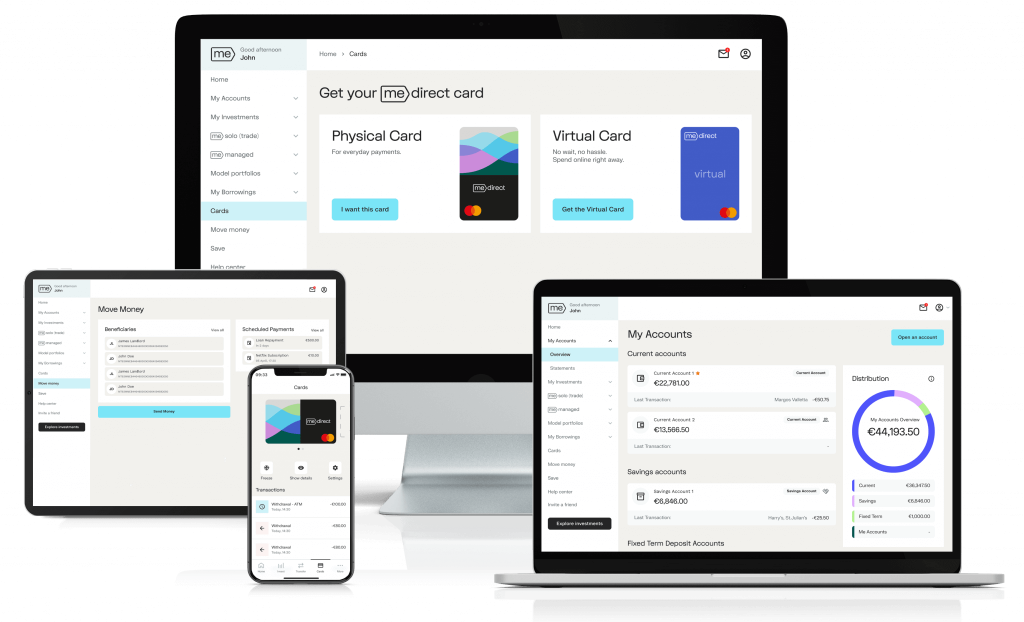 |
An article written by Ray Calleja: Head – Private Clients, MeDirect |
In the previous article we started discussing risk ratios that are used in modern portfolio theory, when it comes to assessing the risk and return of a mutual fund. We described what Standard Deviation, Beta and R-Squared are. Here we will discuss the two remaining risk ratios namely Alpha and the Sharpe Ratio before looking at the two most well-known Morningstar Ratings for funds – the Star and Analyst Ratings. You can find all these ratios and ratings on the Morningstar fund reports on the MeDirect website.
Alpha
It is a risk adjusted performance statistic, which evaluates how good a job a fund manager has done. It will show the added value he or she has made to the fund over and above the return achieved by the market over a specific time period. Alpha is the difference between a fund’s average excess return and the market’s average excess return adjusted for systematic risk, as measured by beta. Systematic risk are factors such as inflation, changes in interest rates, fluctuations in currencies, recessions, pandemics, etc. These are macro factors which influence the direction and volatility of the entire market. In contrast, unsystematic risk is company specific or industry specific risk. You will recall that beta is a measure of a stock’s volatility in relation to the market. It measures the exposure of risk a particular fund or sector has in relation to the market.
A 90-day treasury bill serves as a proxy or substitute for a risk-free investment and it is assumed that the return of a mutual fund should, at the very least, exceed that of a risk-free investment. This figure gives you the fund’s excess return over the risk-free, guaranteed investment. From that, subtract the fund’s expected excess return based on its beta. What’s left over is the alpha.
Let us take the example of a mutual fund which has realised a return of 12% during the last year. The appropriate benchmark index for the fund has a book annual return of 9%. Further, the beta of the mutual fund against its benchmark index is 1.2, while the risk-free rate of return is 3%. Let us calculate the alpha of the fund:
Expected rate of return = Risk-free rate of return + β x (Benchmark return less the Risk-free rate of return)
Expected rate of return = 3% + 1.2 x (9% less 3%) = 10.2%
Therefore, calculation of Alpha of the mutual fund will be as follows:
Alpha of the mutual fund = Actual rate of return less the Expected rate of return
Alpha = 12% – 10.2% = 1.8%
The alpha of the mutual fund is therefore 1.8%.
Positive alpha for a fund indicates that a fund manager delivered a better return than what would be predicted based on the fund’s beta. A negative alpha indicates the opposite, i.e. that the fund manager delivered a worse return than predicted. Alpha can be a helpful tool to evaluate how good a job the fund manager has done. But there are a few issues to keep in mind. A meaningful alpha is completely dependent on a meaningful beta value, i.e. that the benchmark is directly correlated to the mutual fund. Secondly, you should only compare alphas of similar investments. Since we are here talking about mutual funds, you must compare funds within the same category. It is also important to keep in mind that where an unskilled fund manager gets lucky and generate positive alpha while the inverse is also possible where a skilful fund manager could get unlucky during a particular period of time and generate negative alpha.
Sharpe Ratio
As an investor it is easy to fall into the trap to focus solely on the return of a mutual fund. The fund that achieves a higher return is coveted more than the fund which achieves a lower return but we must also take into account risk when assessing an investment. If for example you have two funds which have similar returns, how do you differentiate between one and the other, in terms of risk and return? This is where the Sharpe Ratio can be quite useful. The Sharpe Ratio has become the most widely used method of calculating risk-adjusted returns.
The Sharpe Ratio formula is calculated by dividing the difference of the best available risk-free rate of return (say a short-term Treasury bill) and the average rate of return by the standard deviation (which shows how much variation there is from the mean or average) of the portfolio’s return.
(Portfolio Return – Risk Free Rate) / Portfolio Standard Deviation
We are basically subtracting the risk-free rate of return from the mean return to isolate the return based on the level of risk. We can then evaluate the investment performance based on the risk-free return. Basically, the Sharpe ratio equation adjusts portfolios or mutual funds for risk and puts them all on a level risk playing field, so they can all be compared equally. A higher Sharpe metric is always better than a lower one because a higher ratio indicates that the portfolio is making better investment decisions and not being swayed by the risk associated with it. Here is a list of Sharpe ratio grades and what they mean: <1 – is not considered good; 1-1.99 – is considered good; 2-2.99 – is considered very good; >3 – is considered exceptional.
Let us assume that you want to compare two different mutual funds in your portfolio with different risk levels. Obviously, the riskier of the two will tend to have higher returns, but which one has a higher return relative to the risk associated with the investment? We will use the Sharpe ratio to see which one is performing better.

As you can see, fund B out-performed fund A by a rate of 50% (30% vs 20% return), but this doesn’t mean that fund B performed well relative to its risk level. The Sharpe ratio tells us that fund A actually performed better than fund B relative to the risk involved in the investment. If Fund B performed as well as fund A relative to risk, it would have earned a return of 90%. Fund B may have earned a higher return this year, but it has a higher risk and likelihood of volatility in the future.
It is considered that the Sharpe ratio has a real advantage over alpha. Remember that standard deviation measures the volatility of a fund’s return in absolute terms, not relative to an index. So, whereas a fund’s R-squared must be high for alpha to be meaningful, Sharpe ratios are meaningful all the time.
Moreover, it is easier to compare funds of all types using the standard-deviation-based Sharpe ratio than with beta-based alpha. Unlike beta—which is usually calculated using different benchmarks for equity and bond funds—standard deviation is calculated the exact same way for any type of fund, be it for equities or bonds. We can therefore use the Sharpe ratio to compare the risk-adjusted returns of stock funds with those of bond funds.
As with alpha, the main drawback of the Sharpe ratio is that it is expressed as a raw number. Of course, the higher the Sharpe ratio the better. But given no other information, you cannot tell whether a Sharpe ratio of 1.5 is good or bad. Only when you compare one fund’s Sharpe ratio with that of another fund or a group of funds do you get a feel for its risk-adjusted return relative to other funds.
Morningstar Star Rating
This leads us to the next point in today’s article – the Morningstar star rating. Unlike alpha and the Sharpe ratio, the Morningstar Rating for Funds puts data into context, making it more intuitive. You can find a fund’s Morningstar Rating on its Morningstar fund report.
The star rating is a purely mathematical measure that shows how well a fund’s past returns have compensated shareholders for the amount of risk it has taken on.
Because of the fear of investors of losing money, a fund’s risk rating counts for fully one-half of its overall Morningstar Rating. The other half looks at a fund’s return relative to other funds in its category.
The Morningstar return rating is calculated much the same way as the risk rating. The same combination of time periods is used, i.e. 3-, 5- and 10-year returns go into the calculation. A fund’s returns are also adjusted for any sales charges to better reflect what real-life investors would have earned. As with the risk rating, funds that rank in the top 10% of their categories on the return front earn a return rating of High; the next-best, 22.5% earn a return rating of Above Average, and so on.
This means that Morningstar will have both a risk rating and a return rating for a fund, and the next step is to put them together into an overall rating calculation. By combining risk and return, Morningstar come up with a risk-adjusted return score for each fund in a category. The funds are then ranked according to their scores. The highest-scoring 10% of funds within each category earn five stars, the next 22.5% get four stars, the middle 35% get three stars, the next 22.5% two stars and the worst 10% receive a single star. Star ratings are calculated at the end of every month.
Funds with less than three years of performance history are not rated. For funds with only three years of performance history, their three-year star ratings will be the same as their overall star ratings. For funds with five-year records, their five-year histories will count for 60% of their overall rating and their three-year rating will count for 40% of the overall rating. For funds with more than a decade of performance, the overall rating will be weighted as 50% for the 10-year rating, 30% for the five-year rating, and 20% for the three-year rating.
If a fund changes Morningstar categories during the evaluation period, its historical performance within the other category is given less weight in its star rating, based on the magnitude of the change. (For example, a change from a small-cap category to large-cap category is considered more significant than a change from mid-cap to large-cap). Doing so ensures the fairest comparisons and minimises any incentive for fund companies to change a fund’s style in an attempt to receive a better rating by shifting to another Morningstar category.
As an investor, you can use the star rating to weed out funds that have been too risky for too little gain and focus your search for better managed funds. The star rating can also be used to monitor your existing holdings. It does not mean that you should sell a fund as soon as it loses a star but if one of your funds falls below three stars, then it is time to dig in and find out what’s going on. It may indicate a temporary situation that the fund manager has encountered but it may also indicate a more serious problem.
If a management change occurs the rating stays with the fund, as it does not transfer with the manager to a new fund. That means that a fund’s rating could be based mostly on the performance of a fund manager, who is no longer there. It follows that the star rating is based on how the fund performed in the past and it won’t predict what lies ahead in the future.
Rather than buying funds based on their ratings, investors should first decide on an overall portfolio strategy and then seek the best funds for each portion of their portfolios. Use the star rating as a first screen.
Morningstar Analyst Rating
Morningstar does have a forward-looking metric: the Analyst Rating for funds. The analyst rating is a summary of Morningstar’s conviction in the fund’s ability to outperform its peer group and/or relevant benchmark on a risk-adjusted basis.
Morningstar assigns the Analyst Rating to funds that analysts qualitatively assess, typically through manager interviews and other sources. Morningstar evaluates funds on the basis of five key pillars which they believe identify funds most likely to outperform over the long term on a risk-adjusted basis.
- People – How talented are the fund’s managers and analysts? Do the experience and resources match the strategy?
- Process – What is the fund’s strategy and does management have a competitive advantage enabling it to execute the process well and consistently over time?
- Performance – Is the fund’s performance pattern logical given its process? Has the fund earned its keep with strong risk-adjusted returns over relevant time periods?
- Parent – What priorities prevail at the firm? Stewardship or salesmanship?
- Price – Is the fund a good value proposition compared with similar funds sold through similar channels?
Investors can use the Analyst Rating to form expectations of how a fund will perform over a full market cycle when compared to a relevant benchmark index or similar funds.
The Analyst Rating takes the form of Gold, Silver, Bronze, Neutral, and Negative. The Analyst Rating denotes an analyst’s conviction in a fund’s investment merits. Analysts typically re-evaluate Analyst Ratings on an annual basis.
- Gold rated funds have Morningstar’s highest-conviction recommendations and stand out as best-of-breed for their investment mandate.
- Silver rated funds that fall in this band are high-conviction recommendations. They have notable advantages across several, but perhaps not all, of the five pillars.
- Bronze rated funds have advantages that clearly outweigh any disadvantages, giving the analysts the conviction to award them a positive rating.
- Neutral funds in which Morningstar do not have a strong positive or negative conviction. In their judgement, they are not likely to deliver standout returns, but not likely to seriously underperform either
- Negative funds possess at least one flaw that Morningstar believe is likely to significantly hamper future performance, such as high fees or an unstable management team.
- Under review rating is given to funds where a change to a rated fund requires further review to determine the impact on the rating.
- Not ratable – this designation means either that a fund has failed to provide sufficient transparency to determine a rating, or that Morningstar are providing information on a new strategy where investors require guidance as to suitability, but there is not yet sufficient information to rate the fund.
Morningstar’s analyst teams monitor the strategies they cover for developments that may affect the rating decision and provide updates on such matters as soon as possible. Managed Strategy Analyst Ratings and reports are otherwise updated once per year (report data is updated monthly).
The above is for informative purposes only and should not be construed as an offer to sell or solicitation of an offer to subscribe for or purchase any investment. The information provided is subject to change without notice and does not constitute investment advice. MeDirect Bank (Malta) plc has based this document on information obtained from sources it believes to be reliable but which have not been independently verified and therefore does not provide any guarantees, representations or warranties.
MeDirect Bank (Malta) plc, company registration number C34125, is licensed by the Malta Financial Services Authority under the Banking Act (Cap. 371) and the Investment Services Act (Cap. 370).
The financial instruments discussed may not be suitable for all investors and investors must make their own informed decisions and seek their own advice regarding the appropriateness of investing in financial instruments or implementing strategies discussed herein.
If you invest in any of the products discussed you may lose some or all of the money you invest. The value of your investment may go down as well as up. A commission or sales fee may be charged at the time of the initial purchase for an investment and may be deducted from the invested amount therefore lowering the size of your investment. Any income you get from this investment may go down as well as up. This product may be affected by changes in currency exchange rate movements thereby affecting your investment return therefrom. The performance figures quoted refer to the past and past performance is not a guarantee of future performance or a reliable guide to future performance. Any decision to invest in a mutual fund should always be based upon the details contained in the Prospectus and Key Investor Information Document (KIID), which may be obtained from MeDirect Bank (Malta) plc.





